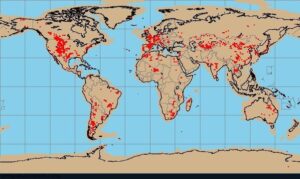Are Dinosaurs Intelligent? Uncovering the Prehistoric IQ
Dinosaurs exhibited varied levels of intelligence, with some species likely being more intelligent than others. Notably, the Troodon is considered one of the smartest dinosaurs.
Dinosaurs roamed the Earth for over 160 million years, with their intelligence varying across different species and evolutionary stages. The cerebral capabilities of these ancient reptiles have intrigued scientists for decades, leading to extensive research on their brain structures. Studies suggest that certain dinosaur species had sophisticated behaviors indicative of higher cognitive functions.
Some, like the Velociraptor, displayed complex social interactions and hunting strategies that point to advanced intelligence. While not all dinosaurs were intellectual giants, clues from fossilized remains, such as the relatively large braincases of certain species, hint at their potential for problem-solving and learning. These insights not only help us understand dinosaur behavior but also provide a fascinating glimpse into the evolutionary lineage of avian intelligence.

Credit: www.dinopit.com

The Great Dinosaur Debate
For years, scientists and enthusiasts alike have puzzled over a question: Were dinosaurs intelligent? This debate takes us back to ancient ecosystems, unveiling the mystery of these magnificent creatures.
Tracing The Iq Quest
To grasp dinosaur intelligence, we turn to their modern relatives. Birds, descendants of theropods, show remarkable smarts. This suggests their ancestors may have had similar cognitive abilities. Exploring this lineage, researchers eye the brain-to-body size ratio, a rough measure of smarts. Dinosaurs had varied ratios, hinting at diverse intelligence levels.
Evidence And Speculation
- Brain Impressions: Fossilized skulls give us endocasts, natural molds of brain cavities. These endocasts reveal brain structure and potential cleverness.
- Tool Use: Direct evidence is scarce, but some dinosaurs may have used objects to dig or for defense.
- Social Behavior: Herding and nesting habits suggest complex interactions, a sign of intelligence.
Yet, evidence often mixes with guesses. Take, for example, the behavior of Deinonychus. Its sophisticated hunting could imply smartness, but without more data, we can’t be sure.

Credit: www.science.org
Brain Size Versus Body Size
Did you know the size of a dinosaur’s brain compared to its body tells us about its smarts? This is the story of brain size versus body size in dinosaurs.
Cephalization Quotients
Scientists use cephalization quotients (CQ) to measure brainpower. A high CQ means a smart animal, and a low CQ means less smarts.
- Big brain, little body? That’s a high CQ.
- Small brain, big body? That’s a low CQ.
Dinosaurs had different CQs. Velociraptor had a higher CQ, suggesting cleverness. The huge Brachiosaurus had a lower CQ, meaning it might not have been as quick-witted.
Comparative Analysis With Modern Animals
When we compare dinosaurs’ CQs to animals today, it gets interesting!
| Dinosaur | Brain Size | Body Size | CQ (Estimate) |
|---|---|---|---|
| Velociraptor | Small | Small | High |
| Brachiosaurus | Small | Huge | Low |
| Dolphin (Modern) | Big | Large | Very High |
Some dinosaurs had brain sizes like modern birds or reptiles. Others were less brainy for their body size, similar to some large mammals today.
Insights From Fossilized Behavior
Did dinosaurs think like we do? Many clues lie buried in ancient rocks. These rocks hold secrets to dinosaur brains and behavior. Let’s dig into what fossils tell us about dino smarts.
Nesting And Herding Instincts
Fossils show that some dinosaurs were smart at family life. They built nests, laid eggs in patterns, and worked together to protect their young. This hints at complex brains.
- Maiasaura made nests close to others, like modern birds do.
- It suggests safeguarding offspring was a group effort.
- Nesting colonies unearthed from rocks over 75 million years old reveal that caring for young was a priority.
Problem-solving In The Fossil Record
Certain fossil tracks hint at problem-solving abilities. Dinosaurs may have planned their paths. A well-preserved site shows dinos avoiding swampy ground, suggesting they understood their environment and adapted to it.
- Tracks zigzagging away from predators indicate quick thinking.
- Tool use isn’t clear, but bite marks on bones suggest they may have used rocks or sticks to get marrow.
- Velociraptor and Troodon left evidence hinting at high intelligence, possibly even hunting in packs.
| Dinosaur | Behavior Clue | Suggests |
|---|---|---|
| Maiasaura | Nesting in groups | Cooperative care |
| Velociraptor | Complex hunting | Strategic thinking |
Evidence of social behavior, like herding, is strong. Fossils reveal dinos moved in groups. Patterns in their footsteps tell stories of organized travel.
- Tracks going in the same direction suggest migration or herd instincts.
- Young dinos found in the middle of herds imply protection strategies.
Discoveries like these open doors to dinosaur intelligence. Each bone and footprint adds to a bigger picture, one where dinos might have been quite clever.
Sophistication In Dinosaur Senses
Dinosaurs roamed the Earth millions of years ago, but did they know their world well? Scholars study fossil clues to understand dinosaur senses. These strong senses may show us how clever these creatures were.
Navigational Skills
Amazing discoveries suggest that dinosaurs had advanced navigational abilities. Scientists believe some species could migrate across vast distances. This ability hints they understood seasons and had a mental map of their landscape. Imagine a T-Rex, keenly aware of its territory, roaming with purpose and direction!
Dinosaur Communication Theories
- Sounds: Fossils of the Parasaurolophus with its long, hollow crest, suggest it might have made low-frequency noises to communicate.
- Visual displays: Features like the bright crests on dinosaurs like the Triceratops may have been for social signaling.
- Scents: Some creatures could have used chemical signals to communicate, much like modern reptiles do.
From loud calls to subtle body language, communication was key in the world of dinosaurs.
Intelligence Through Evolution
The journey of dinosaur intelligence has always intrigued scientists. Insight into their cognitive abilities comes from examining their descendants, birds. The evolution of the reptilian brain into the avian brain provides clues about their intelligence levels. To understand how dinosaurs might have thought and behaved, we explore the evolutionary adaptations that hint at intelligence. Let’s delve into the fascinating world of dinosaur brainpower.
Bird Brains And Dinosaur Descendants
Did you know that today’s birds are modern dinosaurs? Birds evolved from a group of two-legged dinosaurs known as theropods. This group includes the swift Velociraptor and the mighty Tyrannosaurus Rex. Birds inherited complex behaviors from their ancient ancestors. These behaviors suggest intelligence. Birds can solve problems, use tools, and even plan for the future. Traits we associate with high intelligence. Thus, the link between birds and dinosaurs offers valuable clues to how intelligent dinosaurs may have been.
Evolutionary Adaptations For Intelligence
Intelligence comes from the need to adapt. Dinosaurs ruled the Earth for over 150 million years. They faced countless challenges. Climate changes, food scarcities, and predators sculpted dinosaur intelligence. Through evolution, dinosaur brains grew more complex.
- Problem-solving: Finding food and avoiding predators required clever solutions.
- Social behavior: Living in groups meant communicating and working together.
- Environmental interactions: Navigating changing landscapes honed their senses and awareness.
These evolutionary advantages hint at how dinosaurs might have used intelligence to thrive.

Credit: www.amazon.com
Limitations And Challenges In Measurements
Diving into the prehistoric intellect of dinosaurs presents unique challenges. Researchers face hurdles when they try to measure ancient intelligence. This quest involves analyzing fossils and creating theoretical models. Our understanding of dinosaur intelligence evolves. It does so with each new finding and breakthrough.
The Constraints Of Fossil Records
Fossil records are like history books written in stone. They offer snapshots of ancient life. The difficulty lies in deciphering these snapshots. The brain structure, crucial for assessing intellect, rarely fossilizes well. Fossils may offer incomplete data. They sometimes exclude vital areas like the braincase. This limitation means we mostly guess at dinosaur intelligence.
- Braincase rarity: Few preserved specimens.
- Incomplete samples: Often lack detail.
- Indirect evidence: Behavior inferred, not observed.
Theoretical Models Vs. Actual Knowledge
Scientists rely on theoretical models to hypothesize dinosaur intelligence. They use modern animals as a reference. The uncertainty arises because we cannot validate these models. Dinosaurs lived millions of years ago. We cannot accurate comparisons to living creatures.
| Model Type | Use | Limitation |
|---|---|---|
| Brain-to-body mass ratio | Infers potential intelligence | Lacks direct behavioral evidence |
| Endocast study | Estimates brain structure from fossilized cavities | May not reflect actual brain anatomy |
| Neurological comparisons | Draws parallels to existing animals | Assumes similar behavior without proof |
Endocast studies give shape clues but not soft tissue details. Researchers must consider these limits when drawing conclusions.
Frequently Asked Questions For Are Dinosaurs Intelligent
How Smart Are Dinosaurs Compared To Humans?
Dinosaurs were not as intelligent as humans. Human brains are much more complex, enabling higher cognition and problem-solving abilities.
What Dinosaur Has The Highest Iq?
The Troodon is often considered the dinosaur with the highest IQ due to its relatively large brain compared to its body size.
How Intelligent Was The T. Rex?
The T. rex exhibited a degree of intelligence comparable to modern birds and reptiles, with exceptional sensory abilities for hunting. Its brain size suggests it was as smart as its closest living relatives.
Are Dinosaurs Smarter Than Dogs?
Dinosaurs, despite their size, likely were not smarter than modern dogs. Current evidence suggests dogs have more complex social behaviors and learn tasks faster, indicating higher intelligence.
Conclusion
As we’ve explored, dinosaur intelligence remains a captivating puzzle. While they may not match human cognition, evidence suggests some species exhibited complex behaviors. This sheds light on their survival strategies and social structures. Ultimately, understanding dinosaur intellect enriches our knowledge of the ancient world and evolution’s mysteries.
Keep questioning, as science never stops uncovering the past’s secrets.




